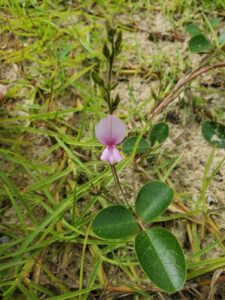How to Propagate Galactia floridana

Unlocking the Secrets of Milkpea Propagation: A Guide to Growing Galactia Floridana
Galactia floridana, more commonly known as Florida Hammock Milkpea or simply Florida Milkpea, is a charming vine with delicate lavender blossoms that attract a myriad of pollinators. This Florida native, prized for its beauty and ecological importance, can be a delightful addition to any wildlife-friendly garden. But how do you go about propagating this charming climber? Let’s delve into the world of Milkpea propagation and unearth its secrets.
The Power of Two: Seed and Cutting Propagation
Florida Milkpea offers two primary avenues for propagation: seeds and cuttings. Each method boasts its own set of advantages, appealing to both novice and seasoned gardeners:
1. The Art of Seed Starting
- Scarification for Success: Milkpea seeds possess a naturally tough outer coat that requires a little nudge to encourage germination.
- Mechanical Scarification: Gently rub the seed coat with sandpaper or a file, creating a small opening for water absorption.
- Hot Water Treatment: Submerge the seeds in hot (not boiling) water for 12-24 hours to soften the coat.
- Sowing the Seeds: Sow the scarified seeds in a well-draining seed starting mix, approximately ¼ inch deep. Keep the soil consistently moist but not waterlogged.
- Patience is Key: Germination times can vary significantly, ranging from a few weeks to several months. Don’t lose hope! Maintain a warm environment and consistent moisture to encourage sprouting.
2. The Efficiency of Cuttings
- Timing is Everything: Early summer is the ideal time to take cuttings, ensuring vigorous new growth.
- Selecting the Perfect Cutting: Choose healthy, non-flowering stems that are approximately 4-6 inches long. Remove any leaves from the bottom half of the cutting.
- Rooting Hormone: A Helpful Boost: While not strictly necessary, dipping the cut end in rooting hormone can significantly enhance the success rate.
- Planting the Cutting: Plant the prepared cutting in a well-draining potting mix. Keep the medium consistently moist and provide indirect sunlight.
- Signs of Success: New leaf growth indicates a successfully rooted cutting.
Creating the Ideal Environment
Regardless of your chosen propagation method, replicating Florida Milkpea’s preferred growing conditions is crucial:
- Sun-Kissed or Lightly Shaded: Opt for a location that receives at least 4-6 hours of sunlight daily. Partial shade during the hottest part of the day is beneficial.
- Well-Drained Soil: Milkpea thrives in well-drained soil that doesn’t become waterlogged. Amending with compost or other organic matter enhances drainage and fertility.
- Supporting the Climb: Provide a trellis, fence, or other support structures for the vine to climb. This encourages healthy growth and enhances its natural beauty.
Reaping the Rewards
Successfully propagating Florida Milkpea comes with a multitude of rewards. Your garden will not only be graced with the beauty of its lavender blossoms but will also become a haven for pollinators like butterflies and bees. The plant’s ability to fix nitrogen in the soil further contributes to a healthy and thriving ecosystem in your own backyard.
So, why wait? Embark on your Milkpea propagation journey today and enjoy the satisfaction of nurturing this beautiful and beneficial plant from seed or cutting to flourishing vine.